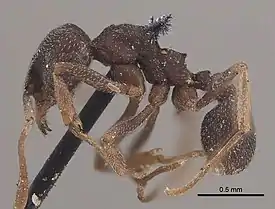Mycetophylax
Mycetophylax (лат.) — род примитивных муравьёв-грибководов трибы Attini из подсемейства Myrmicinae.
| Mycetophylax | ||||||||||
|---|---|---|---|---|---|---|---|---|---|---|
 | ||||||||||
| Научная классификация | ||||||||||
|
Домен: Царство: Подцарство: Без ранга: Без ранга: Без ранга: Без ранга: Тип: Подтип: Надкласс: Класс: Подкласс: Инфракласс: Надотряд: Hymenopterida Отряд: Подотряд: Инфраотряд: Надсемейство: Семейство: Подсемейство: Триба: Род: Mycetophylax |
||||||||||
| Международное научное название | ||||||||||
| Mycetophylax Emery, 1913 | ||||||||||
| Синонимы | ||||||||||
|
Paramycetophylax Kusnezov |
||||||||||
| Виды | ||||||||||
|
См. статью |
||||||||||
| ||||||||||
Описание
Рабочие мономорфные. Лобные валики средних размеров, волоски редкие, тело гладкое. Характерны своим тесным симбиозом с грибами, выращиваемыми в муравейниках. Семьи малочисленные, состоят из одной матки и примерно сотни рабочих. Стебелёк между грудкой и брюшком состоит из двух члеников: петиолюса и постпетиолюса (последний чётко отделён от брюшка), жало развито, куколки голые (без кокона)[1]. Гнездо состоит из одной или двух ячеек-камер. В качестве субстрата для грибницы используют остатки трав[2]. Диплоидный хромосомный набор: 2n = 26 (M. morschi), 2n = 30 (M. conformis, M. morschi), 2n = 36 (M. simplex)[3][4].
Распространение
Род характерен исключительно для Нового Света и встречается только на прибрежных песчаных пляжах и отмелях Бразилии[1].
Классификация
Род включает 3 валидных вида (ранее выделяли до 20 видов, подвидов и вариететов)[5][6][7].
- валидные таксоны[5]
- другие бывшие виды
- Mycetophylax bruchi (Santschi, 1916)[11]
- выделен в род Paramycetophylax Kusnezov, 1956 (Paramycetophylax bruchi)
- = Mycetophylax cristulatus (Santschi, 1922) (синоним) [12]
- Mycetophylax emeryi (Forel, 1907)[13]
- выделен в род Kalathomyrmex Klingenberg, 2009 (Kalathomyrmex emeryi)
- = Mycetophylax glaber Weber, 1948 (синоним)[14]
- Mycetophylax bruchi (Santschi, 1916)[11]
Примечания
- D. C. Cardoso, M. P. Cristiano and M. G. Tavares. 2011. Methodological remarks on rearing basal Attini ants in the laboratory for biological and evolutionary studies: overview of the genus Mycetophylax. (недоступная ссылка) // Insectes Sociaux. Volume 58, Number 3, 427—430, doi:10.1007/s00040-011-0160-3 (англ.) (Дата обращения: 8 октября 2011)
- Hölldobler B., Wilson E. O. The Ants. — Harvard University Press, 1990. — P. 606. — 732 p. — ISBN 0674040759.
- Cardoso DC, das Graças Pompolo S, Cristiano MP, Tavares MG (2014). The Role of Fusion in Ant Chromosome Evolution: Insights from Cytogenetic Analysis Using a Molecular Phylogenetic Approach in the Genus Mycetophylax. PLoS ONE 9(1): e87473. https://doi.org/10.1371/journal.pone.0087473
- Moura M. N., Cardoso D.C., Lima Baldez B.C., Cristiano M. P. Intraspecific variation in the karyotype length and genome size of fungusfarming ants (genus Mycetophylax), with remarks on procedures for the estimation of genome size in the Formicidae by flow cytometry (англ.) // PLoS ONE : Журнал. — 2020. — Vol. 15, no. 8. — P. e0237157. — doi:10.1371/journal.pone.0237157.
- Klingenberg C, Brandao CRF (2009) Revision of the fungus–growing ant genera Mycetophylax Emery and Paramycetophylax Kusnezov rev. stat., and description of Kalathomyrmex n. gen. (Formicidae: Myrmicinae: Attini). Zootaxa (2052): 1–31.
- Cardoso DC, Carvalho CR, Cristiano MP, Soares FA, Tavares MG (2012) Estimation of nuclear genome size of the genus Mycetophylax Emery, 1913: evidence of no whole-genome duplication in Neoattini. Comptes Rendus Biologies 335(10—11): 619—624.
- Cardoso DC, Cristiano MP, Heinze J, Tavares MG (2014). A nuclear DNA based phylogeny of endemic sand dune ants of the genus Mycetophylax (Emery, 1913): how morphology is reflected in molecular data. Mol Phylogenet Evol 70: 378–382.
- Radoszkowsky, O. 1884: Fourmis de Cayenne Française. // Trudy Russkago Entomologicheskago Obshchestva, 18: 30-39.
- Emery, C. 1888: Formiche della provincia di Rio Grande do Sûl nel Brasile, raccolte dal dott. Hermann von Ihering. // Bollettino della Societa Entomologica Italiana, 19: 352—366.
- Diehl-Fleig E. and Diehl E. 2007. Nest architecture and colony size of the fungus-growing ant Mycetophylax simplex Emery, 1888 (Formicidae, Attini). Insect. Soc. 54: 242–247
- Santschi, F. 1916: Formicides sudaméricains nouveaux ou peu connus. // Physis, 2: 365—399.
- Santschi, F. 1922: Myrmicines, dolichodérines et autres formicides néotropiques. // Bulletin de la Societe Vaudoise des Sciences Naturelles, 54: 345—378. (в оригинале как Sericomyrmex bruchi Santschi, 1916)
- Forel, A. 1907: Nova speco kaj nova gentonomo de formikoj. // Internacia Scienca Revuo, 4: 144—145.
- Weber, N.A. 1948: Studies on the fauna of Curaçao, Aruba, Bonaire and the Venezuelan islands: no. 14. Ants from the Leeward group and some other Caribbean localities. // Natuurwetenschappelijke Studiekring voor Suriname en Curacao, 5: 78—86.
Литература
- B. Bolton, A new general catalogue of the ants of the world, Harvard University Press, Cambridge, MA, 1995.
- Cardoso, D.C., das Graças Pompolo, S., Cristiano, M.P. & Tavares, M.G. (2014). The role of fusion in ant chromosome evolution: insights from cytogenetic analysis using a molecular phylogenetic approach in the genus Mycetophylax. PLoS One, 9, e87473.
- Cardoso DC, Cristiano MP, Tavares MG (2011). Methodological remarks on rearing basal Attini ants in the laboratory for biological and evolutionary studies: overview of the genus Mycetophylax. Insectes Sociaux 58, 3: 427–430.
